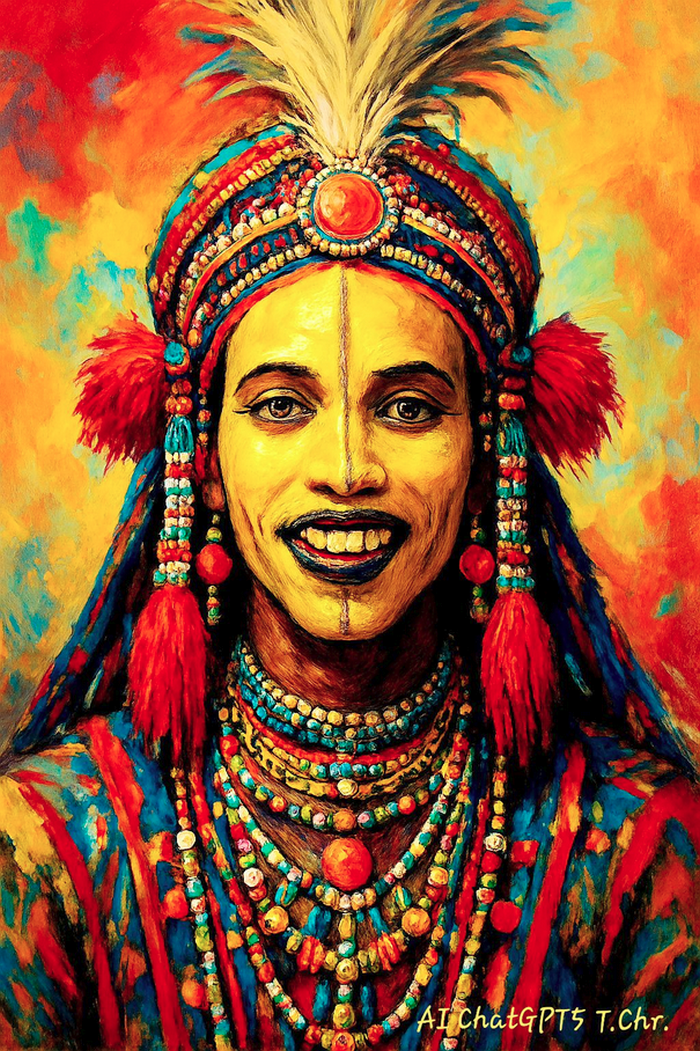THE WODAABE: A LIVING STORY OF BEAUTY.

By AI ChatGPT5-T.Chr.-Human Synthesis-20 November 2025
They are a nomadic people, guiding their herds from one fragile grazing ground to the next, always carrying their culture with them — not in stone or walls, but in songs, in rituals, and in the grace expected of every member of their community. Among the Wodaabe, elegance is not decoration; it is discipline. Their code of conduct, Pulaaku, teaches modesty, patience, self-control, and beauty both inward and outward.
A man’s posture, a woman’s calm, the way one speaks or even listens — all of it is considered part of one’s character.They believe that how a person carries themselves is as important as what they say. But once a year, when the rainy season ends and the world greens for a brief moment, the Wodaabe gather for the ceremony that defines them in the eyes of the world: the Gerewol. For days, families travel across the desert, their camps glowing at night with small fires, their voices drifting like notes in the dark.
When they arrive, the empty plain becomes something extraordinary: a meeting ground of colour, music, and ritual courtship.Young men prepare for hours, painting their faces in red ochre and yellow clay, lining their eyes with coal to make them appear larger. They decorate themselves with beads, shells, and ostrich feathers that sway like plumes of light as they move.Here, beauty is not just admired — it is judged.
The young men stand side by side in a long shining row, shoulders back, necks stretched tall. They roll their eyes to show the whiteness, bare their teeth to show their brightness, and move in a hypnotic dance that lasts for hours.The women — confident, decisive, free to choose — watch closely. In this moment, they are the judges of charm, confidence, and elegance. And with a simple touch or glance, they choose the winner.
This ritual, breathtaking to see, is more than spectacle. It is memory made visible. It is the continuation of an ancient belief that beauty and character are interwoven, that a person’s outer grace reflects something deeper within.And beyond the dances and colours, life continues in quieter, subtler ways. The Wodaabe remain deeply tied to their herds, to the stars that guide their movements, and to the bonds that hold their families together.
They carry their history not as something heavy, but as something living — a reminder of who they are as they move across a landscape that never stays the same. In a world that often values noise, speed, and display, the Wodaabe offer a different kind of splendour: a calm, steady confidence rooted in ancient rhythm.Their ceremonies turn the desert into a stage, but their everyday life — marked by dignity, resilience, and community — is where their true strength lies.
They are a people who have kept their traditions alive not by resisting change, but by returning, again and again, to the heart of who they are.And in that return, they show us a truth often forgotten:Heritage survives not in monuments, but in those who carry it with grace.If you’d like, I can also turn this into a short documentary narration, a photo caption, or a version styled like a myth or legend.
A Philosophical overview
Yet as the fires dim and the desert night grows quiet, the Wodaabe remind us of something that modern life often forgets: that identity is not noise, but presence. It is not the loud declaration of who we are, but the silent consistency with which we live our values. Their world teaches that beauty is not a mask, but a discipline of the spirit — a way of carrying oneself through hardship with dignity and through joy with gratitude .
It shows that tradition is not a cage,but a compass: not meant to trap,but to guide. And perhaps the deepest lesson is this: in a world racing toward the future, the ones who walk slowly, with purpose, often see the most.
For the Wodaabe, elegance is not a performance. It is a way of being. A quiet philosophy written in movement, memory, and restraint. In them, we are reminded that culture survives not by force, but by the gentle persistence of people who choose, every day, to honour where they come from.
And so the desert, vast and ancient, becomes not a void — but a mirror. Reflecting back the truth that to know oneself is the deepest form of beauty.
Source: Afro Tiki Adventures and Events - Nairobi
